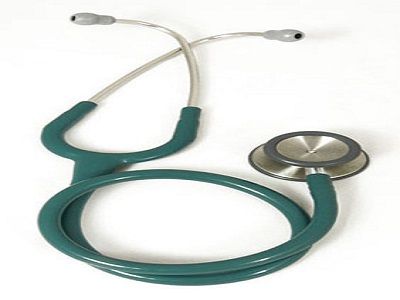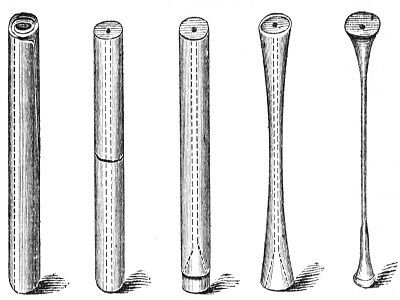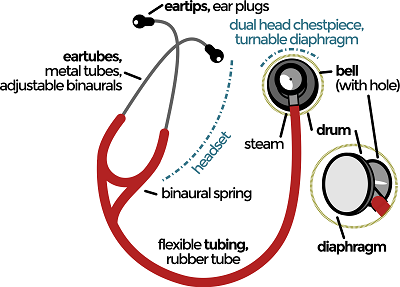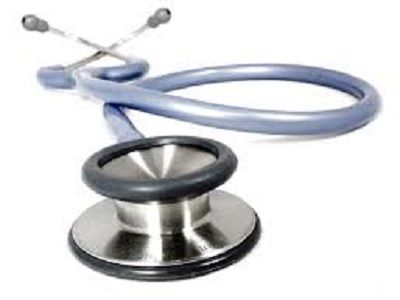The science and working principle of stethoscope

I could still recall being a little boy that I accompanied my mother to a nearby hospital to show sympathy to a friend of mine who fell sick. On getting to the hospital I received the shock of my life and fear grips my heart as a gentle man on white regalia (doctor) came in to examine him. The doctor brought out something that looks like a rope and placed it on my friend’s chest (patient) and he wrote something down. In my quest to know what it was, I whispered into my mummy’s ear and she laughed. Immediately it was as if the doctor has read my mind and he whispered back to me saying my son this is a stethoscope
This now gave birth to what I want to discuss with you which is: the working principle of a typical stethoscope.
In this article, you will get to know:
What gave birth to stethoscope?
Definition of a typical stethoscope
Component of a typical stethoscope
Science and working principle behind stethoscope
And types of stethoscope
The use of stethoscope can be traced as far back as 1816. It was invented by a French physician named Rene Laennec by using a long rolled paper tube to funnel the patient’s sound from the chest to his ear rather than directly placing his ear on patient’s chest. It was clearly noted that there was a great improvement of the acoustic properties of the tube which gave him the ability to hear both the heart and lung sound.

The name stethoscope was coined from two Greek words; stethos (which means chest) andskopein (which means to see or view). He termed his method of using the stethoscope as ‘auscultation’ from ‘auscultare’ (listen).
After 20years of the first invention by Rene Laennec, George P.Camman of New York improved on the existing stethoscope and came out with the first stethoscope with an earpiece for each ear.
Stethoscope is a device normally use by medical practitioners to listen to the sound that is coming out internally from human body or an animal and blood pressure (BP) in veins and arteries. The structure of a typical stethoscope consists of a round shaped resonator or chest piece and a long tube. The tubes are connected to the ears while the resonator is placed on the chest to transmit the sound. These devices are used to monitor acoustic sound variation and also to check the scientific vacuum chambers.
Over the years there were need to digitize the device in other to enhance effectiveness and efficiency which brought about the design of acoustic and electronic stethoscope. The only difference between acoustic and electronic stethoscope is that electronic stethoscope uses battery and it’s also amplifies the sound more audible than acoustic stethoscope.
COMPONENTS OF A TYPICAL STETHOSCOPE
A typical stethoscope consists of:

A round shaped resonator or chest piece
The round shaped resonator is made up of a bell and diaphragm.Tubing
Binaural
And a pair of head-set
ROUND SHAPE RESONATOR: this part of the stethoscope touches the chest of the patient to capture his/her chest’s sound. The round shape resonator consists of a diaphragm and a bell.
THE DIAPHRAGM: this is the lower part of the chest piece. It is a flat metallic disc surrounded by chill rings which enable it to pick a very high pitch sound.
BELL: The smaller or other part of the resonator is called bell. It is made up of hollow piece of metal which helps at picking up low frequency sounds.
TUBING: This is a long tube made of polyvinyl chloride and latex rubber. The properties of its content allow flexibility and durability, and it helps to reach the patient with ease.
HEAD SET: This part of the stethoscope is responsible for transmission of the sound from the round shaped resonator to the listener’s ears. A metal is always inserted into the stethoscope tubing to convey the sound. The ear tip of the headset is always surrounded by a rubber which serves as a support to the headset and also plays an important part in how the stethoscope functions. The ear tip also safe guard the headset from any external interference such as noise and echo. It also enhances comfort ability in the use of the stethoscope.
BINAURAL: These are metallic piece that are inserted into the stethoscope tube, which directly plays the role of transmitting the sound from the chest piece into the listener’s ears. The binaural is covered up with the stethoscope tube as a protector and its tip is also surrounded by the ear tips.
WORKING PRINCIPLE OF A TYPICAL STESTHOSCOPE
We have known from the definition above that stethoscope is a device normally used by medical practitioners to listen to the sound that is coming out internally from human body or an animal majorly placed at the chest.
Whenever a medical practitioners place a stethoscope diaphragm on a chest of a patient, a vibration will occur at the flat surface of the stethoscope which is as result of sound waves that is being generated from the patient’s body. The vibration picked by the diaphragm is being protected externally in other to prevent sound loss and thereby channeled through the tube to a specific direction.
Inside the tube, a multiple reflection tends to occurs as a result of wave collision within the wall of the tube. And this continues in succession until it reaches the ear tips at the other ends of the device before being picked by the listener’s eardrum.

The heartbeats are of high pitch which connote that they travel at a very high frequencies and causes a lot of pressure variation at a given period of time. The sound waves produced as a result of opening and closing of an artery thereby set the diaphragm into vibration and the same sound wave travels through the stethoscope tube to the listener’s ear.
The working principle of the bell is different from that of the diaphragm. It has a smaller surface area and it was designed in such a way that it detects and picks up a lower pitched of sound. It picks up the vibration of the body in contact caused by that movement rather than the vibration of the arteries directly which then vibrate the bell.
TYPES OF STETHOSCOPE
Over the years, different modifications have been carried out on the earliest stethoscope which gave birth to different stethoscope types as a result of high demand, and also because of technological advancement in other to improve its efficiency and effectiveness. The two major types of stethoscope are listed below.
- Acoustic
- Electronic
ACOUSTIC STETHOSCOPE: this type of stethoscope is most commonly seeing around and it works base on transmission of sound waves emanating from the round shaped resonator with the help of hollow tubes which help to convey it to the listener’s ear. The round shaped resonator consists of two parts (diaphragm and a bell) that are normally placed against the patient to sense the level of their body organ sound. The diaphragm transmits high frequency sound while the bell is used to transmit lower frequency sound. Initially, the major problem encountered in the use of acoustic stethoscope was that they have poor amplification but it was later modified in the year 1999 with the incorporation of continuous lumen.
ELECTRONIC STETHOSCOPE: Electronic stethoscope work in the same way as the acoustic stethoscope but it has some other features that help to eliminate the lapses of acoustic stethoscope by incorporating amplifiers and speakers to amplify the low frequencies sound and as well attenuate high-and low-frequency range sounds.

Thanks for reading
Please note: all images used in this post are labelled for reuse
Hi @emmatech. Nice piece. By the way, you have mentioned that:
The term "electronic" here describe only a portion of all the stethoscope. Not all are electronic so if it were up to me, I would write "Stethoscope is a device....." instead.
You are absolutely correct, @emmatech try an correct that part. Thank you.
@greenrun thanks, the necessary correction has been done
@chloroform i am very grateful, the correction has been done
đến bây giờ tôi mới hiểu được nguyên tắc của chúng
Congratulations @emmatech! You received a personal award!
You can view your badges on your Steem Board and compare to others on the Steem Ranking
Do not miss the last post from @steemitboard:
Vote for @Steemitboard as a witness to get one more award and increased upvotes!
Congratulations @emmatech! You received a personal award!
You can view your badges on your Steem Board and compare to others on the Steem Ranking
Do not miss the last post from @steemitboard:
Vote for @Steemitboard as a witness to get one more award and increased upvotes!